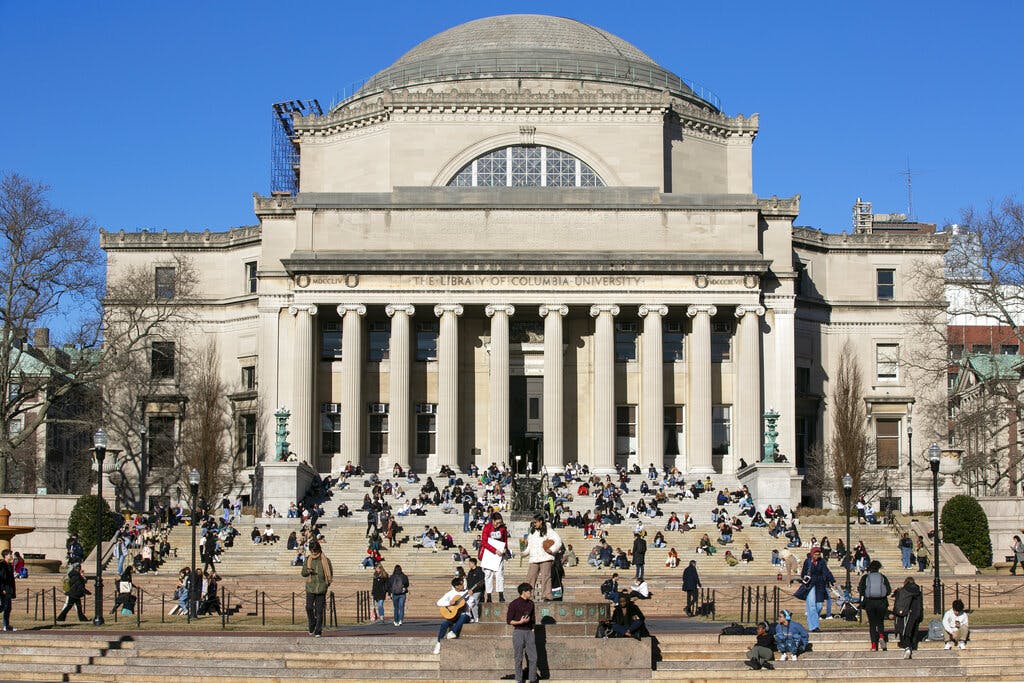Trump’s War on Higher Education Will Be Waged Beyond Elite Universities
Critics warn that some educational institutions could face existential danger.

President Trump is seeking to squeeze the finances of leading universities like Columbia and the University of Pennsylvania. But trouble could soon come for hundreds of schools outside the elite 1 percent, ranging from small liberal arts colleges like Davidson in North Carolina to public research universities like Iowa State, as the administration wields a coast-to-coast campaign to transform higher education.
In just the first two months of the presidency, Trump has moved to choke critical revenue streams for colleges and universities. The National Institutes of Health and other federal agencies have terminated research grants and halted review of new grant applications. The NIH is also seeking to slash the rate it pays in indirect cost reimbursements for university research in the name of cutting the “Liberal D.E.I. Deans’ slush fund,” in an effort to save taxpayers $4 billion per year.
During his election campaign, Trump vowed “to reclaim our once great educational institutions from the radical Left.” Aligned with that goal, the Department of Education is cancelling grants supporting programs that include diversity, equity and inclusion initiatives because they are “inconsistent with, and no longer effectuates, Department priorities,” according to termination letters in lawsuits.
The thinking guiding the administration is that “universities are part of the ecosystem of the Left,” a professor of political science at Johns Hopkins, Benjamin Ginsberg, tells the Sun. “They’re part of the progressive not-for-profit domain that employs 12 and a half million people, and that is the heart of the Democratic party.”
Meanwhile, 60 universities are under investigation by the Department of Education for potentially antisemitic harassment and discrimination, and 45 universities are being scrutinized by the department for engaging in “race-exclusionary practices.” Trump has threatened to pull their federal funding if they do not comply.
Asked by the Sun about these threats, the chairman of the House Committee on Education and Workforce, Tim Walberg, points to the “heartbreaking stories of Jewish students who have been threatened and harassed by both their classmates and professors.” Mr. Walberg says “these students finally have an ally in the White House which has presented colleges and universities with a simple choice — adhere to federal laws prohibiting harassment and other forms of discrimination or risk federal funding.”
The primary targets are elite schools. But also at risk of substantial losses are the nearly 500 regional public universities across America — serving about half of all undergraduates enrolled in public universities. Those that spend up at least $2.5 million on scientific studies qualify as research schools, and they get up to a quarter of their funding from federal grants — or an even greater fraction if they have a hospital system.
The changes will bring about “The End of the University as We Know It,” an English professor at Yale, Meghan O’Rourke, wrote in the New York Times. Leaders of public universities in red states like Alabama and Kentucky are also sounding the alarm bells, warning in lawsuits and dire pleas that cuts to science and research funding could devastate public institutions seen as economic engines in their regions. “This change isn’t a cost savings; it’s a cost transfer that either intentionally reduces the scale and scope of our research programs,” the president of the University of Nebraska system, Jeffrey Gold, wrote in a letter to students and faculty.
Already, a few large institutions have frozen hiring, cut spending, reduced the number of graduate students accepted, or implemented layoffs. “If courts allow more grants to be cancelled or the indirect cost reimbursement rate to be cut, expect more and deeper cuts,” a researcher of higher education finance, Robert Kelchen, tells the Sun.
Take the example of Iowa State, which received a record $236.3 million in federal research funding in the 2024 fiscal year, including grants from the Departments of Energy and Agriculture, the National Science Foundation, and the National Aeronautics and Space Administration. Iowa State’s Office of the Vice President for Research recently warned its researchers that executive orders signed by the Trump administration “could potentially impact both awarded projects and those awaiting funding from federal agencies or sponsors.”
Cuts could be existential for universities already facing budgetary pressures amid overall declining student enrollment. Though campuses are expecting their largest freshman class ever this fall, this peak is predicted to dramatically drop off in the next decade as recruiting officers brace for a “demographic cliff.”
Colleges and universities already experienced a 15 percent decrease in enrollment between 2010 and 2021, the most recent year for which figures are available, according to the National Center for Education Statistics. As a consequence, over the last 10 years, 15 percent of colleges have closed or merged, a lecturer at Harvard University on the future of education, Michael Horn, has found. He expects this figure to grow to as great as 40 percent over the next 5 years.
West Virginia University and the University of Nebraska have been struggling for several years due to enrollment declines. Penn State and the University of Connecticut have long faced state budget challenges. “In those cases, universities have to make deeper cuts because they were not in a good place prior to Trump taking office,” says Mr. Kelchen, a professor of higher education at the University of Tennessee, Knoxville.
The success of the pressure campaign against elite private colleges suggests to some analysts that big blue-state public universities like UC-Berkeley, UCLA, University of Michigan, and Rutgers, will be next. Then smaller liberal arts colleges could be targeted. They rely less on research dollars, but if there are any potential disruptions to federal financial aid, they could find it harder to make payroll and balance their tight budgets.
According to Mr. Kelchen, even getting loan payments two weeks later than they were expecting could cause some serious issues. (The Trump administration has said that neither their federal funding cuts, nor a potential dissolution of the Department of Education, will affect access to Pell Grants and student loans).
A potential endowment tax is also a cause for concern at private universities both big and small. Republican Congressman Troy Nehls has introduced a bill to increase the tax from 1.4 percent — “far lower than what most hardworking Americans pay in taxes,” he said — to 21 percent, the same rate that for-profit corporations pay. This would affect colleges with 500 or more tuition-paying students and at least $500,000 in endowment funds per student.
An endowment tax could hurt colleges’ ability to provide financial aid to students, as the president, Douglas Hicks, of Davidson College in Davidson, North Carolina — perhaps best known as the alma mater of basketball star Stephen Curry — argued at Capitol Hill last week.
Yet proponents of aggressive higher education reform argue that it’s long overdue. “There’s no doubt that colleges and universities will be scrambling, and part of that scramble should be necessary cuts in their administrative bloat and other budget lines that aren’t really relevant to their educational missions,” says Mr. Ginsberg, who authored a book on this topic: “The Fall of the Faculty: The Rise of the All-Administrative University and Why It Matters.”
While much of the academic community has expressed concerns over potential impairment to university research and innovation, Mr. Ginsberg asserts that cuts could be beneficial in the long term. “I think though it will be painful, we will ultimately be better off if colleges and universities are more realistic about their budgetary practices. They have been living in a dream world of taxpayer support.”

